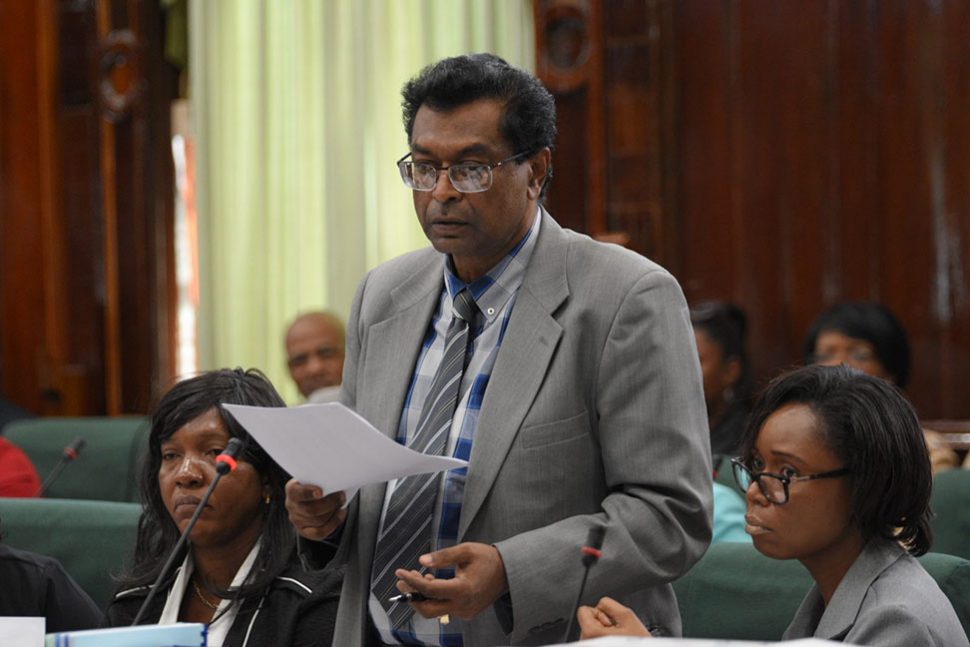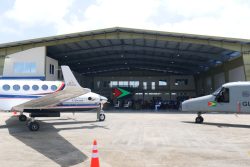Public Security Minister Khemraj Ramjattan yesterday said his ministry is seeking to reorganise the Guyana Prison Service (GPS), which would see higher salaries and other incentives to make it more “attractive and appealing” to potential recruits.
Ramjattan was at the time responding to questions about his confidence in the strength of the GPS during scrutiny by the opposition in the Committee of Supply.
A total of $21 billion was yesterday approved for five programmes under the Ministry of Public Security as the consideration of estimates for the 2019 national budget concluded on Friday. Included in that sum is $3.9 billion for the GPS.
Ramjattan was also asked what is being done to stop the smuggling of illegal substances into the prisons, to which he said, “That is to do with surveillance systems that we are going to get through this budget and also professionalism that we will have to get through the process of continued training and leadership of ranks also personal judgement calls by these officers and ranks. But, of course, to scrutinise them we will have to get the equipment.”
He added, “We have to have a culture, too, around the country that family members shouldn’t be paying them the monies to carry in the contraband, so all of that are considerations.”
Meanwhile, under the under the capital expenditure, $1.4 billion has been allocated for prisons, which will cover the retention for the construction of 60 inmate units for the Georgetown Prison at a cost of $6,144,000; reconstruction of the Georgetown Prison at a cost of $265 million; and the expansion of the Mazaruni Prison at a cost of $709 million as well as a consultancy of $77 million.
Elaborating further on the plans for the Georgetown Prison, Ramjattan said, “We are dealing here with a company out of America that has provided steel cell prisons for a number of countries in the Caribbean and Latin America. It is a cell modular kind of arrangement, whereby we can pack the cells up and go different heights up—two storeys, and three storeys whatever. So, it is easily portable. So, if in view of the fact that we now have that and we want to move from Georgetown and go to Lusignan or Kuru Kururu, wherever we proposed our next locations, these steel sets can be easily removable to those areas. So it’s not going to be a permanent structure there, there might be some changes of plans in the future about having the prison in the heart of the city.”
The minister was also asked if any changes have been made to the design for construction of the Mazaruni Prison and whether the changes were made before or after the signing of the contract.
In his response, Ramjattan explained that there have been no changes apart from that which was already effected by the National Security Committee and the President.
“There is no change in design as far as I am aware of but initially it was supposed to be a four-storey building and then that was changed by the National Security Committee and the president saying that we would not have water for a four-storey and that it would be a fire hazard, so we have to redesign for a two-storey and expand the area where we will have the two-storey building… This decision was taken after the signing of the contract,” he noted.
Some 20% of works have been completed thus far, which is reflective of a cost that is in excess of $500 million, the minister added.
Contract workers
Meanwhile, regarding the $1.4 billion allocated for policy development and administration under his ministry, Ramjattan was asked about efforts to transition contracted workers to the pension scheme, since it was noted that 48% of the staff of the ministry are currently contract workers. Included among the lot are the Director and Deputy Director of the National Anti-Narcotic Agency (NANA), the personal assistant to the minister, the Head of the Drug Information Network and the Head of the Strategic Management Department.
Ramjattan explained that the ministry is working with the Public Service Ministry to address the situation. He also explained that vacancies had existed for the mentioned positions and as a result the Ministry had to use contractual agreements to engage office holders.
Concerns were also raised by PPP/C parliamentarian Juan Edghill, who questioned the $10 million that was spent on the rental of a building, considering that no allocations were made for this purpose in 2018. However, the minister explained that the funds were taken from another line item for rental of a Parade Street, Kingston Office for NANA, since the existing building could not comfortably accommodate the staff.
‘SOCU Top Up’
It was also disclosed that nine officers attached to the Guyana Police Force’s Special Organised Crime Unit (SOCU) are usually paid a “top up” by the Ministry of Public Security in addition to their salaries, which are being paid by the Guyana Police Force.
This came to light following questions by Edghill.“I understand it not a salary. It is what is called a ‘top up’ for working at SOCU and we inherited that arrangement,” Ramjattan said, while noting that the ministry continues to work with this arrangement since it is one that attracts persons with qualifications in finance and experience in financial and white collar crime investigations.
Regarding the $13.8 billion allocated for the Guyana Police Force, over $400 million has been budgeted to cover the payment of retention for rehabilitation of the senior officers’ living quarters at Eve Leary, the rehabilitation of Springlands Police Station, the Lethem Police Station, the New Amsterdam Police Station, the Cove and John Police Station, and the construction of La Parfaite Harmonie Police Station and the Matthews Ridge Police Station.
Further, the Guyana Police Force as part of the realignment of divisions into regional divisions, will see the construction of Divisional headquarters at Golden Grove, Fort Wellington, Mabaruma and Mahdia, each at a cost of $50 million.
Additionally, over $200 million has been budgeted for purchase of vehicles, boats, engines, motorcycles and a further $220 million for the purchase of arms and ammunition; fingerprint, ballistic, photography, handwriting, and communication materials; and equipment for narcotics operations, intelligence, traffic, and crime scene investigations.
Meanwhile, the Police Complaints Authority in 2019 will receive an approved sum of $44 million, while the Guyana Fire Service and the Customs Anti-Narcotic Unit will receive $1.9 billion and $349 million, respectively.








